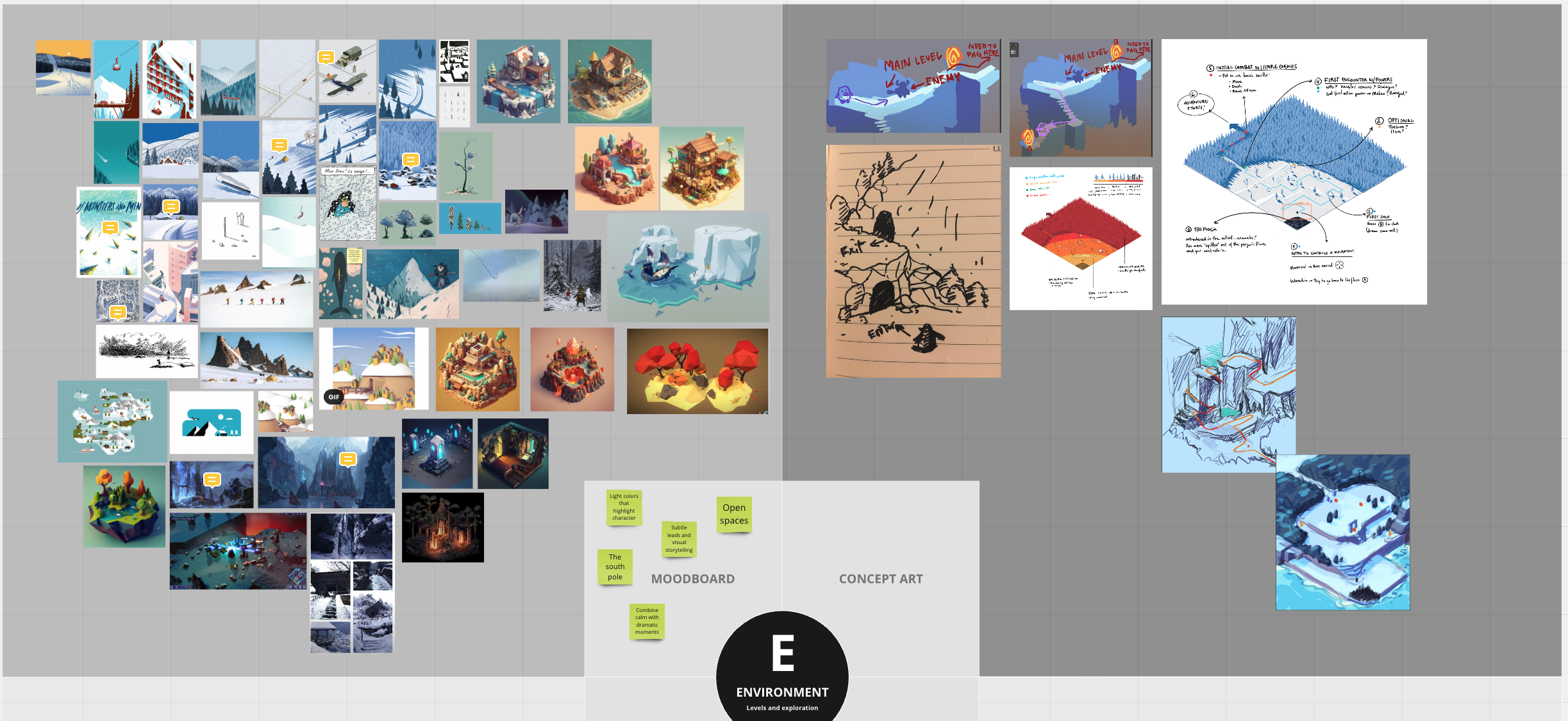Aalto’s Devlog #9 / 18th September - 4th October 2023
Untitled Penguin Game (1/3)
-
Initial ideas and references for our penguin game.
-
Creating sample animations in Blender.
-
Coming up with level design ideas to teach the basic mechanics and introduce the narrative.
The game project course is the pivotal part of our degree. It consists in two game projects that will be developed in the span of three months. In this particular case, I joined a team as Game Artist, Animator and UI Designer. Nevertheless, everyone in the team will wear many hats during the development process. The game pitch that got selected was to create an action-adventure game featuring a penguin in an isometric world. The game will tell a story about growth, while keeping combat and exploration mechanics.
Game Project I
About the Course
Fu Wei, Nuutti Nykänen, Fatemeh Amereh, Jami Liang, Hedi (Moonatic), Esther Calderón, Néstor Feijoo Melián.
Team
Sketches & Moodboard
01
During the first weeks of the development, we focused on defining the high-level pitch presented during the team-forming session. During this ideation period, I created sketches, did art related research, proposed ideas for the narrative and kept everything organized in moodboards. I developed art direction tasks in thsharing sketches and ideas for the characters and the environment art. I also created a storyboard for the initial sequence, that will probably be developed in the future.
Sketch of a ‘cold-handed’ penguin
WIP Moodboard focused on the main character
WIP Moodboard focused on the environment
Defining the game’s emotional range
Flipper and the Untamed
Emotional Expression: Flipper, the main character, begins the story by expressing his emotions in a raw and unfiltered way. It is angry and as a result its wings became frozen. It is casted out of the flock because of this, and it will start its journey by fighting birds with its powers, shooting ice everywhere and becoming a snowball breaking walls. This behavior is a common aspect of childhood, as children often struggle to understand and manage their emotions. Flipper’s initial outburst represents the uncontrolled and untamed aspect of childhood emotions.
Escapism: Flipper’s journey to the Land of the Untamed can be seen as an escape from the real world, a place where he can freely explore and express his emotions. This is a common coping mechanism for children, as they sometimes retreat into their imaginations to deal with difficult or overwhelming feelings. In the story, Flipper’s adventures with the Untamed provide him with a safe space to confront and understand his emotions.
Confronting and Taming Emotions: As Flipper interacts with the Untamed and becomes their king, he begins to understand that even these wild and uncontrollable emotions can be tamed and channeled in constructive ways (puzzle, ice sculpting). He learns that it's possible to assert control and authority over his own feelings. This reflects a key aspect of emotional growth in children: the development of emotional regulation and self-control.
Returning Home: After his adventures, Flipper decides to return home. This signifies a maturation of his character and a realization that, no matter how wild or untamed his emotions may be, there is always a place for him in the comfort and love of his family. This reflects the idea that children, as they grow emotionally, come to appreciate the stability and security that their families provide.
Emotional Resilience: Flipper’s journey and interactions with the Untamed also suggest that facing and working through difficult emotions can build emotional resilience. By confronting his anger and loneliness in the fantasy world, he becomes better equipped to handle these emotions in the real world. This reflects a common aspect of childhood development, where children learn to cope with and adapt to various emotional challenges.
Storyboard for the initial cinematic
Animation Tests
On a personal note, the biggest challenge I will be facing during this project will be the animation. Even though I have previous experience working with 2D animation, this will be my first time animating in 3D. I face this task with optimism and as an opportunity of developing a new skillset and, to avoid being overwhelmed by the complexity of it, I chose to start from the basics. After drawing sketches of how I imagined the movement of our funny penguin, I jumped right into blender to model a basic dummy. As I got more comfortable with Blender’s animation system, I was ready to start animating a basic enemy. I was able to make some progress in a short period of time and, before our first playtest, I was able to have a basic animation set for both the player and the first basic enemy. Soon enough we had our first characters moving into the Unreal Engine!
02
Sketches for animation
First rough animations made in Blender
Animation sequence for the first basic enemy
3D animations playing in Unreal Engine
Level design
03
I made some sketches and schemes for the tutorial level. This stage’s goal is to teach the basic mechanics to the player and to introduce the narrative. I am fond of games that teach you how to play without needing too much explanation, an that’s what I tried to achieve with this first ideas.
Idea for a tutorial/introductory level
Mood progression visualizer for the tutorial/introductory level
WIP game scheme for the starting level
More from Aalto’s Devlog:
-

Untitled Penguin Game (2/3)
Period 2 - Game Project I
-

Airplane control and procedural map in Unity with C#
Period 1 - Software Studies for Game Designers
-

Game Jam: Mamapato
Period 0 - Introductory Game Jam












